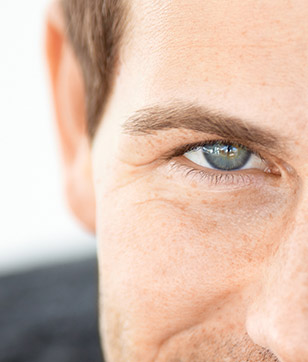
In order for the eye to stay healthy, it must remain moist. The lacrimal gland, a specialized structure located under the outer one third of the upper eyelid, helps to make tears. Each time you blink, your eyelid spreads tears over the surface of the eye and pumps excess tears towards ducts in both the upper and lower eyelids. These ducts then drain the tears into your nose.
Lacrimal Obstruction is usually caused by an infection with the "tear pipe" located in the nose. This infection causes swelling in the inner corner of the eyelid. Approximately seven percent of infants are born with a congenital obstruction of their tear drainage system (the lacrimal duct) in either one or both eyes. This percentage is even higher in premature babies. In most infants, the obstruction is caused by a membrane at the base of the tear duct just before the duct enters the nose.
| Symptoms of acquired and congenital lacrimal obstruction | |
| Tearing or Watering | Obstruction of the tear duct will cause tearing or watering of the eye because the tears cannot drain properly. |
| Mucous | Eyelashes may stick together with mucous or an accumulation of tears in one or both eyes. |
| Swelling | The tears trapped within the duct may become infected, causing a painful swelling in the inner corner of the eyelid. |

Excessive tearing or eye discharge should be examined by an ophthalmologist to determine the cause of the problem. In some children, excessive tearing may be caused by another condition besides tear duct obstruction. The membrane that causes the obstruction in infants will usually open on its own within three to four weeks after birth. If this does not occur, your physician will recommend treatment to open the blockage.
Initial treatment involves massaging the area over the affected tear sac (located under the skin between the eye and nose) to force the tears and mucous from the sac and hopefully pushing open the membrane causing the obstruction. In infants, this massage requires the active involvement of the parent, as it must occur frequently. Massage is generally continued until the tearing resolves. Antibiotic drops or ointments may also be prescribed by the physician.
If the obstruction is still present, it may be necessary to open the tear duct by probing and irrigation. Probing is most commonly performed between six months and one year of age in infants. The probing is performed by passing a thin probe down the tear drainage system in an attempt to open the blockage. Minimal pain is associated with this procedure. After the probing, bloodstained tears or a slight nosebleed may occur. These side effects are brief. Antibiotic drops or ointments may be prescribed. Unfortunately, blockages may recur in spite of probing. If the tearing persists, then a silicone tube may be placed down the duct to keep the tear draining system open. The tubes are tiny, generally imperceptible, and usually remain in place for twelve months to prevent the obstruction from recurring.
Treatment for acquired and congenital lacrimal obstruction depends on the exact cause. If the tear drainage system is blocked, surgery to open the blockage may be necessary. The type of surgery depends on the location of the blockage. For example, it may be necessary to make an additional opening from the lacrimal sac into the nose, a procedure known as a dacryocystorhinostomy or DCR. If the problem is dry eyes, however, artificial tear replacement or even closure of the tear drainage (puncta) may be helpful.
At Miami Eye Center, Dr. Joseph Selem will meet with you during your private consultation to assess your individual situation. Dr. Selem can help you decide if Lacrimal System Surgery in Miami is right for you. See the beauty in yourself and the world around you in crisp, clear detail today! Request an appointment online or call Dr. Joseph Selem and the staff at Miami Eye Center at 305-444-0221 to schedule your private consultation.
